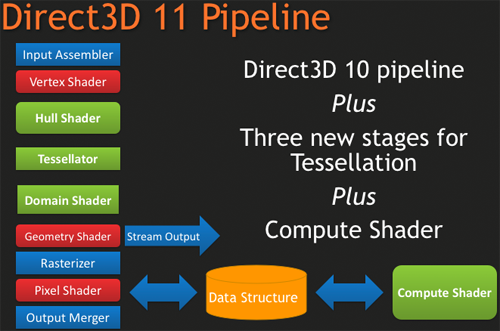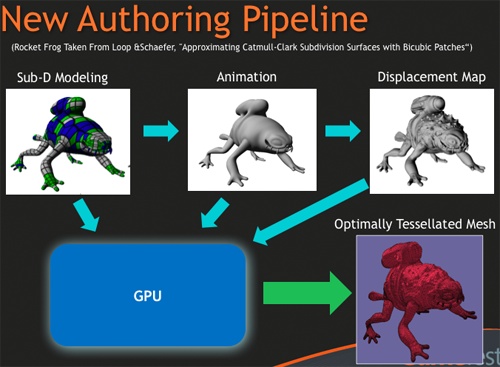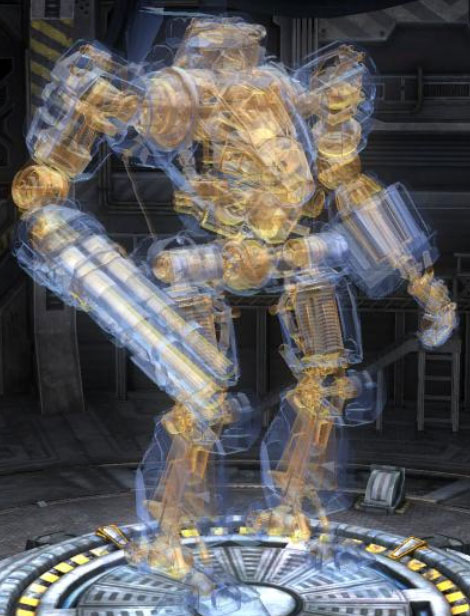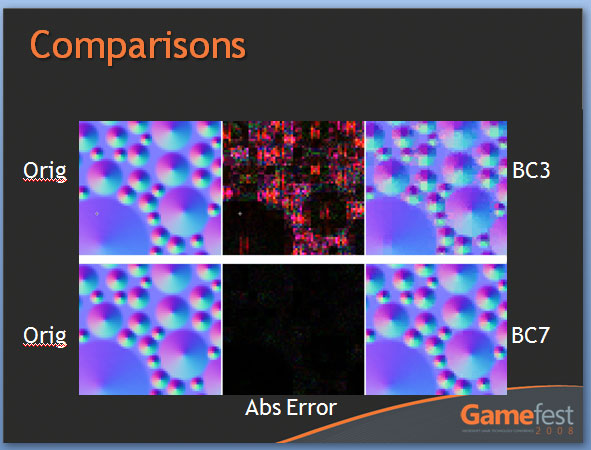AMD's Radeon HD 5870: Bringing About the Next Generation Of GPUs
by Ryan Smith on September 23, 2009 9:00 AM EST- Posted in
- GPUs
DirectX11 Redux
With the launch of the 5800 series, AMD is quite proud of the position they’re in. They have a DX11 card launching a month before DX11 is dropped on to consumers in the form of Win7, and the slower timing of NVIDIA means that AMD has had silicon ready far sooner. This puts AMD in the position of Cypress being the de facto hardware implementation of DX11, a situation that is helpful for the company in the long term as game development will need to begin on solely their hardware (and programmed against AMD’s advantages and quirks) until such a time that NVIDIA’s hardware is ready. This is not a position that AMD has enjoyed since 2002 with the Radeon 9700 and DirectX 9.0, as DirectX 10 was anchored by NVIDIA due in large part to AMD’s late hardware.
As we have already covered DirectX 11 in-depth with our first look at the standard nearly a year ago, this is going to be a recap of what DX11 is bringing to the table. If you’d like to get the entire inside story, please see our in-depth DirectX 11 article.
DirectX 11, as we have previously mentioned, is a pure superset of DirectX 10. Rather than being the massive overhaul of DirectX that DX10 was compared to DX9, DX11 builds off of DX10 without throwing away the old ways. The result of this is easy to see in the hardware of the 5870, where as features were added to the Direct3D pipeline, they were added to the RV770 pipeline in its transformation into Cypress.

New to the Direct3D pipeline for DirectX 11 is the tessellation system, which is divided up into 3 parts, and the Computer Shader. Starting at the very top of the tessellation stack, we have the Hull Shader. The Hull Shader is responsible for taking in patches and control points (tessellation directions), to prepare a piece of geometry to be tessellated.
Next up is the tesselator proper, which is a rather significant piece of fixed function hardware. The tesselator’s sole job is to take geometry and to break it up into more complex portions, in effect creating additional geometric detail from where there was none. As setting up geometry at the start of the graphics pipeline is comparatively expensive, this is a very cool hack to get more geometric detail out of an object without the need to fully deal with what amounts to “eye candy” polygons.
As the tesselator is not programmable, it simply tessellates whatever it is fed. This is what makes the Hull Shader so important, as it’s serves as the programmable input side of the tesselator.
Once the tesselator is done, it hands its work off to the Domain Shader, along with the Hull Shader handing off its original inputs to the Domain Shader too. The Domain Shader is responsible for any further manipulations of the tessellated data that need to be made such as applying displacement maps, before passing it along to other parts of the GPU.

The tesselator is very much AMD’s baby in DX11. They’ve been playing with tesselators as early as 2001, only for them to never gain traction on the PC. The tesselator has seen use in the Xbox 360 where the AMD-designed Xenos GPU has one (albeit much simpler than DX11’s), but when that same tesselator was brought over and put in the R600 and successive hardware, it was never used since it was not a part of the DirectX standard. Now that tessellation is finally part of that standard, we should expect to see it picked up and used by a large number of developers. For AMD, it’s vindication for all the work they’ve put into tessellation over the years.
The other big addition to the Direct3D pipeline is the Compute Shader, which allows for programs to access the hardware of a GPU and treat it like a regular data processor rather than a graphical rendering processor. The Compute Shader is open for use by games and non-games alike, although when it’s used outside of the Direct3D pipeline it’s usually referred to as DirectCompute rather than the Compute Shader.
For its use in games, the big thing AMD is pushing right now is Order Independent Transparency, which uses the Compute Shader to sort transparent textures in a single pass so that they are rendered in the correct order. This isn’t something that was previously impossible using other methods (e.g. pixel shaders), but using the Compute Shader is much faster.

Other features finding their way into Direct3D include some significant changes for textures, in the name of improving image quality. Texture sizes are being bumped up to 16K x 16K (that’s a 256MP texture) which for all practical purposes means that textures can be of an unlimited size given that you’ll run out of video memory before being able to utilize such a large texture.
The other change to textures is the addition of two new texture compression schemes, BC6H and BC7. These new texture compression schemes are another one of AMD’s pet projects, as they are the ones to develop them and push for their inclusion in DX11. BC6H is the first texture compression method dedicated for use in compressing HDR textures, which previously compressed very poorly using even less-lossy schemes like BC3/DXT5. It can compress textures at a lossy 6:1 ratio. Meanwhile BC7 is for use with regular textures, and is billed as a replacement for BC3/DXT5. It has the same 3:1 compression ratio for RGB textures.
We’re actually rather excited about these new texture compression schemes, as better ways to compress textures directly leads to better texture quality. Compressing HDR textures allows for larger/better textures due to the space saved, and using BC7 in place of BC3 is an outright quality improvement in the same amount of space, given an appropriate texture. Better compression and tessellation stand to be the biggest benefactors towards improving the base image quality of games by leading to better textures and better geometry.
We had been hoping to supply some examples of these new texture compression methods in action with real textures, but we have not been able to secure the necessary samples in time. In the meantime we have Microsoft’s examples from GameFest 2008, which drive the point home well enough in spite of being synthetic.

Moving beyond the Direct3D pipeline, the next big feature coming in DirectX 11 is better support for multithreading. By allowing multiple threads to simultaneously create resources, manage states, and issue draw commands, it will no longer be necessary to have a single thread do all of this heavy lifting. As this is an optimization focused on better utilizing the CPU, it stands that graphics performance in GPU-limited situations stands to gain little. Rather this is going to help the CPU in CPU-limited situations better utilize the graphics hardware. Technically this feature does not require DX11 hardware support (it’s a high-level construct available for use with DX10/10.1 cards too) but it’s still a significant technology being introduced with DX11.
Last but not least, DX11 is bringing with it High Level Shader Language 5.0, which in turn is bringing several new instructions that are primarily focused on speeding up common tasks, and some new features that make it more C-like. Classes and interfaces will make an appearance here, which will make shader code development easier by allowing for easier segmentation of code. This will go hand-in-hand with dynamic shader linkage, which helps to clean up code by only linking in shader code suitable for the target device, taking the management of that task out of the hands of the coder.










327 Comments
View All Comments
SiliconDoc - Wednesday, September 30, 2009 - link
I was here before this site was even on the map let alone on your radar, and have NEVER had any other acct name.I will wait for your APOLOGY.
ol1bit - Friday, September 25, 2009 - link
Goodbye 8800gt SLI... nothing has given me the bang for the buck upgrade that this card does!I paid $490 for my SLI 8800Gt's in 11/07
$379 Sweetness!
Brazos - Thursday, September 24, 2009 - link
I always get nostalgic for Tech TV when a new gen of video cards come out. Watching Leo, Patrick, et al. discuss the latest greatest was like watching kids on Christmas morning. And of course there was Morgan.totenkopf - Thursday, September 24, 2009 - link
SiliconDoc, this is pathetic. Why are you so upset? No one cares about arguing the semantics of hard or paper launches. Besides, where the F is Nvidias Gt300 thingy? You post here more than amd fanboys, yet you hate amd... just hibernate until the gt300 lauunches and then you can come back and spew hatred again.Seriously... the fact that you cant even formulate a cogent argument based on anything performance related tells me that you have already ceded the performance crown to amd. Instead, you've latched onto this red herring, the paper launch crap. stop it. just stop it. You're like a crying child. Please just be thankful that amd is noww allowing you to obtain more of your nvidia panacea for even less money!
Hooray competition! EVERYONE WINS! ...Except silicon doc. He would rather pay $650 for a 280 than see ati sell one card. Ati is the best thing that ever happened to nvidia (and vice versa) Grow the F up and dont talk about bias unless you have none yourself. Hope you dont electrocute yourself tonight while making love to you nvidia card.
SiliconDoc - Thursday, September 24, 2009 - link
" Hooray competition! EVERYONE WINS! ...Except silicon doc. He would rather pay $650 for a 280 than see ati sell one card."And thus you have revealed your deep seated hatred of nvidia, in the common parlance seen.
Frankly my friend, I still have archived web pages with $500 HD2900XT cards from not that long back, that would easily be $700 now with the inflation we've seen.
So really, wnat is your red raving rooster point other than you totally excuse ATI tnat does exactly the same thing, and make your raging hate nvidia whine, as if "they are standalone guilty".
You're ANOTHER ONE, that repeats the same old red fan cleche's, and WON'T OWN UP TO ATI'S EXACT SAME BEHAVIOR ! Will you ? I WANT TO SEE IT IN TEXT !
In other words, your whole complaint is INVALID, because you apply it exclusively, in a BIASED fashion.
Now tell me about the hundres of dollars overpriced ati cards, won't you ? No, you won't. See that is the problem.
silverblue - Friday, September 25, 2009 - link
If you think companies are going to survive without copying what other companies do, you're sadly mistaken.Yes, nVidia has made advances, but so has ATI. When nVidia brought out the GF4 Ti series, it supported Pixel Shader 1.3 whereas ATI's R200-powered 8500 came out earlier with the more advanced Pixel Shader 1.4. ATI were the first of the two companies to introduce a 256-bit memory bus on their graphics cards (following Matrox). nVidia developed Quincunx, which I still hold in high regard. nVidia were the first to bring out Shader Model 3. I still don't know of any commercially available nVidia cards with GDDR5.
We could go on comparing the two but it's essential that you realise that both companies have developed technologies that have been adopted by the other. However, we wouldn't be so far down this path without an element of copying.
The 2900XT may be overpriced because it has GDDR4. I'm not interested in it and most people won't be.
"In other words, your whole complaint is INVALID, because you apply it exclusively, in a BIASED fashion. " Funny, I thought we were seeing that an nauseum from you?
Why did I buy my 4830? Because it was cheaper than the 9800GT and performed at about the same level. Not because I'm a "red rooster".
ATI may have priced the 5870 a little high, but in terms of its pure performance, it doesn't come too far off the 295 - a card we know to have two GPUs and costs more. In the end, perhaps AMD crippled it with the 256-bit interface, but until they implement one you'll be convinced that it's a limitation. Maybe, maybe not. GT300 may just prove AMD wrong.
SiliconDoc - Wednesday, September 30, 2009 - link
You have absolutely zero proof that we wouldn't be further down this path without the "competition".Without a second company or third of fourth or tenth, the monopoly implements DIVISIONS that complete internally, and without other companies, all the intellectual creativity winds up with the same name on their paycheck.
You cannot prove what you say has merit, even if you show me a stagnant monopoly, and good luck doing that.
As ATI stagnated for YEARS, Nvidia moved AHEAD. Nvidia is still ahead.
In fact, it appears they have always been ahead, much like INTEL.
You can compare all you want but "it seems ati is the only one interested in new technology..." won't be something you'll be blabbing out again soon.
Now you try to pass a lesson, and JARED the censor deletes responses, because you two tools think you have a point this time, but only with your deleting and lying assumptions.
NEXT TIME DON'T WAIL ATI IS THE ONLY ONE THAT SEEMS INTERESTED IN IMPLEMENTING NEW TECHGNOLOGY.
DON'T SAY IT THEN BACKTRACK 10,000 % WHILE TRYING TO "TEACH ME A LESSON".
You're the one whose big far red piehole spewed out the lie to begin with.
Finally - Friday, September 25, 2009 - link
The term "Nvidiot" somehow sprung to my mind. How come?silverblue - Thursday, September 24, 2009 - link
Youre spot on about his bias. Every single post consists of trash-talking pretty much every ATI card and bigging up the comparative nVidia offering. I think the only product he's not complained about is the 4770, though oddly enough that suffered horrific shortage issues due to (surprise) TSMC.Even if there were 58x0 cards everywhere, he'd moan about the temperature or the fact it should have a wider bus or that AMD are finally interested in physics acceleration in a proper sense. I'll concede the last point but in my opinion, what we have here is a very good piece of technology that will (like CPUs) only get better in various aspects due to improving manufacturing processes. It beats every other single GPU card with little effort and, when idle, consumes very little juice. The technology is far beyond what RV770 offers and at least, unlike nVidia, ATI seems more interested in driving standards forward. If not for ATI, who's to say we'd have progressed anywhere near this far?
No company is perfect. No product is perfect. However, to completely slander a company or division just because he buys a competitor's products is misguided to say the least. Just because I own a PC with an AMD CPU, doesn't mean I'm going to berate Intel to high heaven, even if their anti-competitive practices have legitimised such criticism. nVidia makes very good products, and so does ATI. They each have their own strengths and weaknesses, and I'd certainly not be using my 4830 without the continued competition between the two big performance GPU manufacturers; likewise, SiliconDoc's beloved nVidia-powered rig would be a fair bit weaker (without competition, would it even have PhysX? I doubt it).
SiliconDoc - Thursday, September 24, 2009 - link
Well, that was just amazing, and you;re wrong about me not complaining about the 4770 paper launch, you missed it.I didn't moan about the temperature, I moaned about the deceptive lies in the review concerning temperatures, that gave ATI a complete pass, and failed to GIVE THE CREDIT DUE THAT NVIDIA DESERVES because of the FACTS, nothing else.
The article SPUN the facts into a lying cobweb of BS. Juzt like so many red fans do in the posts, and all over the net, and you've done here. It is so hard to MAN UP and admit the ATI cards run hotter ? Is is that bad for you, that you cannot do it ? Certainly the article FAILED to do so, and spun away instead.
Next, you have this gem " at least, unlike nVidia, ATI seems more interested in driving standards forward."
ROFLMAO - THIS IS WHAT I'M TALKING ABOUT.
Here, let me help you, another "banned" secret that the red roosters keep to their chest so their minions can spew crap like you just did: ATI STOLE THE NVIDIA BRIDGE TECHNOLOGY, ATI HAD ONLY A DONGLE OUTSIDE THE CASE, WHILE NVIDIA PROGRESSED TO INTERNAL BRIDGE. AFTER ATI SAW HOW STUPID IT WAS, IT COPIED NVIDIA.
See, now there's one I'll bet a thousand bucks you never had a clue about.
I for one, would NEVER CLAIM that either company had the lock on "forwarding technbology", and I IN FACT HAVE NEVER DONE SO, EVER !
But you red fans spew it all the time. You spew your fanboyisms, in fact you just did, that are absolutely outrageous and outright red leaning lies, period!
you: " at least, unlike nVidia, ATI seems more interested in driving standards forward...."
I would like to ask you, how do you explain the never before done MIMD core Nvidia has, and will soon release ? How can you possibly say what you just said ?
If you'd like to give credit to ATI going with DRR4 and DDR5 first, I would have no problem, but you people DON'T DO THAT. You take it MUCH FURTHER, and claim, as you just did, ATI moves forward and nvidia does not. It's a CONSTANT REFRAIN from you people.
Did you read the article and actually absorb the OpenCL information ? Did you see Nvidia has an implementation, is "ahead" of ati ? Did you even dare notice that ? If not, how the hell not, other than the biased wording the article has, that speaks to your emotionally charged hate Nvidia mindset :
"However, to completely slander a company or division just because he buys a competitor's products is misguided to say the least."
That is NOT TRUE for me, as you stated it, but IT IS TRUE FOR YOU, isn't it ?
---
You in fact SLANDERED Nvidia, by claiming only ATI drives forward tech, or so it seems to you...
I've merely been pointing out the many statements all about like you just made, and their inherent falsehood!
---
Here next, you pull the ol' switcharoo, and do what you say you won't do, by pointing out you won't do it! roflmao: " doesn't mean I'm going to berate Intel to high heaven, even if their anti-competitive practices have legitimised such criticism.."
Well, you just did berate them, and just claimed it was justified, cinching home the trashing quickly after you claimed you wouldn't, but have utterly failed to point out a single instance, unlike myself- I INCLUDE the issues and instances, pointing them out imtimately and often in detail, like now.
LOL you: " I'd certainly not be using my 4830 without ...."
Well, that shows where you are coming from, but you're still WRONG. If either company dies, the other can move on, and there's very little chance that the company will remain stagnant, since then they won't sell anything, and will die, too.
The real truth about ATI, which I HAVE pointed out before, is IT FELL OFF THE MAP A FEW YEARS BACK AND ALTHOUGH PRIOR TO THAT TIME WAS COMPETITIVE AND PERHAPS THE VERY BEST, IT CAVED IN...
After it had it's "dark period" of failure and depair, where Nvidia had the lone top spot, and even produced the still useful and amazing GTX8800 ultimate (with no competition of any note in sight, you failed to notice, even to this day - and claim the EXACT OPPOSITE- because you, a dead brained red, bought the "rebrand whine" lock stock and barrel), ATI "re-emerged", and in fact, doesn't rteally deserve praise for falling off the wagon for a year or two.
See, that's the truth. The big fat red fib, you liars can stop lying about is the "stagnant technology without competition" whine.
ATI had all the competition it could ever ask for, and it EPIC FAILED for how many years ? A couple, let's say, or one if you just can't stand the truth, and NVIDIA, not stagnated whatsoever, FLEW AHEAD AND RELEASED THE MASSIVE GTX8800 ULTIMATE.
So really friend, just stop the lying. That's all I ask. Quit repeating the trashy and easily disproved ati cleche's.
Ok ?